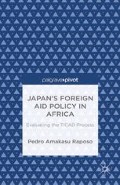Abstract
By focusing on the evolution of TICAD from 1993 to 2013, it is evident that TICAD is now part of Japan’s foreign aid policy and development assistance discourse. To deny that would be to refute 20 years of devoted effort toward African development at the highest and field level between African governments, the Japanese government, civil society, and other TICAD co-organizers. The visibility TICAD provides, the scope of its policies and priorities, the influence it has and the development outcome in Africa through sharing Asian experiences is remarkable. Ultimately, TICAD is a process that has made advances and suffered setbacks. Its sustainability should be a common effort.
Access this chapter
Tax calculation will be finalised at checkout
Purchases are for personal use only
Preview
Unable to display preview. Download preview PDF.
Author information
Authors and Affiliations
Copyright information
© 2014 Pedro Amakasu Raposo
About this chapter
Cite this chapter
Raposo, P.A. (2014). Conclusion. In: Japan’s Foreign Aid Policy in Africa: Evaluating the TICAD Process. Palgrave Pivot, New York. https://doi.org/10.1057/9781137493989_8
Download citation
DOI: https://doi.org/10.1057/9781137493989_8
Publisher Name: Palgrave Pivot, New York
Print ISBN: 978-1-349-50476-3
Online ISBN: 978-1-137-49398-9
eBook Packages: Palgrave Intern. Relations & Development CollectionPolitical Science and International Studies (R0)

